Syliver Byabasaija
Other projects
7 Oct 2022
Understanding Local Community Perception, and Potential of Sustainable Aquaculture Development in Ecologically Sensitive Areas of Lake Victoria Crescent, Uganda
Invasive plant species are having major effects on ecosystems of the world and are thought to be the second leading threat to Biodiversity (CDB, 2005). This project will therefore focus on areas of invasive plant invasion ecology and how to integrate surrounding communities in management, to increase the knowledge of the impacts of invasive plant species and their control on resident plants and the functioning of reserve ecosystems. Understanding of the mechanisms responsible for the establishment of invasive plant species. The project objectives are to determine the spatial distribution of different invasive plant species on Maputo special Reserve, assess the social impacts of invasive species on the communities within close proximity to Maputo Special Reserve. Determining whether invasive plant species cause changes in the abundance of plants with domestic use and Raise community awareness on different strategies that can be put in place to address invasive plants occurrence in reserve.

Eucalyptus, one of the identified exotic plants in Maputo Special Reserve.
In Maputo Special Reserve, Invasive Plant Species (IPS) are currently regarded as one of the threats to conservation of the area biodiversity following direct habitat destruction. The reserve serves as heritage site that supports several watersheds, birdlife and is a habitat of some endangered plants and animal species. Regardless of these uses, the native plant species are threatened by invasive plants though competition .The surrounding communities who depend on the reserve for collection of products like herbal medicine, grass for thatch, wild fruit, mushrooms, honey, and fibre are under threat due to the presence of Invasive Plant Species hence an impact on their livelihoods. Wildlife like elephants are also under threat as the reserve pastures are being destroyed by Invasive plant Species like lantana camara. Although the above consequences are noted, there is limited efforts that have tried to consolidate information on Invasive Plant Species on Maputo Special reserve and its subsequent effect to community as well.
The objectives of this project are 1) To determine the spatial distribution of different Invasive Plant Species in the Reserve 2) Assess the social impacts of Invasive Plant species on the communities within close proximity to special Reserve.3) Determining whether the plant invasive species cause changes in the abundance of plants with domestic use.4) To raise community awareness about different strategies that can be put in place to address invasive plants occurrence in reserve.
To achieve these objectives, both social and field data will be collected as well as holding training workshops for different stakeholders. Data collection will be through use of questionnaires targeting key respondents that will include members of the communities surrounding the reserve as well as reserve management team.
The point centered quarter method will also be used in determine the spatial distribution of invasive plants. Data will be sorted and organized in and Microsoft Office Excel and later analysed using Chi square test at 95% confidence level and reported as text in form of reports, journal articles and other that can be accessed by different stakeholders.
Members of the community surrounding the reserve as well as Reserve management team will be involved in different training workshops that will be organised with the prime aim to raise awareness on the best approaches for management of Invasive Plants Species.
Expected outputs:
1. Will raise awareness of stakeholders including the local communities about different strategies of managing invasive plants.
2. Produce a map of the distribution of Invasive plants on the reserve for proper Management action.
3. Results of this project will be published in articles for raising awareness at national, regional and global level on the ecological impacts of invasive plants.